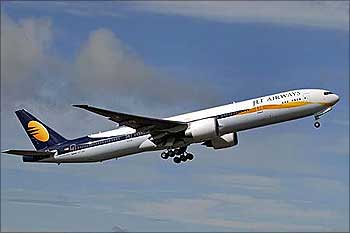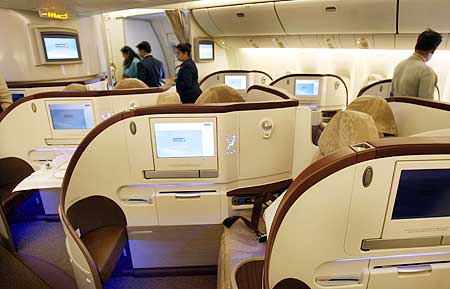BS Bureau
Now that the Jet Airways pilots' strike is over and the airline's services are back to normal, it is tempting to forget about the episode as yet another example of an industrial dispute getting resolved quite quickly after it boiled over.
The strike, however, raises several questions which need to be addressed.
For one, Jet's handling of the situation suggests that the airline needs serious lessons in human resource management.
The pilots had given a month's notice to the management, during which nothing happened.
Then, Jet sacked two pilots for forming a union, and then sacked two more, which forced the other pilots to stand by their colleagues.
It would seem that the Jet management has not learnt anything from the fallout of its mass sacking of cabin crew last year, namely that people have to be dealt with, with understanding and sensitivity.
Lessons to learn from the Jet pilots' strike
Image: Naresh Goyal, chairman, Jet Airways.Photographs: Vijay Mathur/Reuters
The larger issue is that raised by the Jet Airways chairman, Naresh Goyal, who has asked how pilots earning Rs 300,000-400,000 a month can be equated with shop-floor workers who are entitled under the law to launch industrial action, like striking work.
His argument is that pilots get paid very well, and are in charge of the planes they fly -- that is, they perform a vital supervisory/management role in that they command a plane and its crew.
No one, for instance, has heard of a ship's captain going on strike on a wage issue! So how are airline pilots different?
Lessons to learn from the Jet pilots' strike
Image: Aircraft at the Mumbai airport.Photographs: Reuters
There are two different arguments involved here, and they need to be dealt with separately.
First, to say that a manager has the right to strike is surely an oxymoron. It is important for the government to realise this and make the necessary changes in the law.
Pilots in other airlines have struck work in the past, and the Jet strike very nearly spread to the rest of the industry as associations of pilots in other airlines threatened to go on strike if their managements started extra flights to make up for the seat scarcity caused by the Jet strike.
Lessons to learn from the Jet pilots' strike
Image: Kingfisher Airlines chairman Vijay Mallya speaks at a press conference.Photographs: Luke MacGregor/Reuters
The right to collective bargaining and industrial action flowed from the realisation about a century ago that worker-management relations were usually weighted in favour of managements, and that the only strength of workers (often uneducated and poorly versed) lay in numbers and collective action.
This was seen to more than neutralise the counter-point that industrial action is per se coercive as are many lock-outs announced by managements.
Lessons to learn from the Jet pilots' strike
Image: People look at the newly introduced premier class cabin in a Jet Airways Boeing 777-300 ER.Photographs: Punit Paranjpe/Reuters
So it is a moot point whether employees like pilots should enjoy the same right, especially when aviation is a service industry that affects thousands of passengers -- thereby multiplying the coercive power of collection action.
An easy way out is to simply declare that airline services are an essential service, under the Essential Services Maintenance Act, but the more fundamental issue has to be addressed, as to whether very highly-paid employees who enjoy job mobility and who occupy responsible positions should be categorised as 'workmen' and given legal cover for coercive collective action.







article